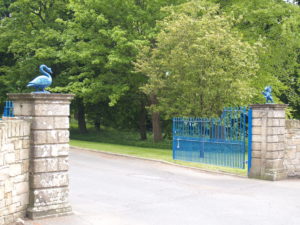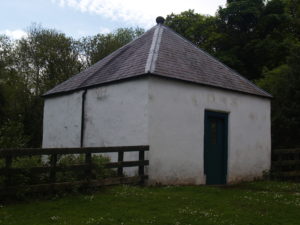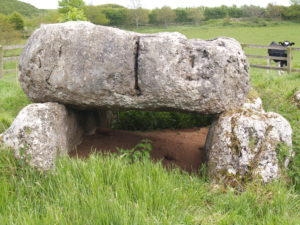“Loughry, the ancestral home of the Lindesay’s, stands on fair ground. Sheltered by beech woods the ancient stone house looks out towards rolling hills while a near-by stream babbles continuous music”.
These words, penned by a member of the Lindesay family, describe the place known to them as home since 1611, when the land around Loughry was granted to Robert Lindesay by James I.
Robert Lindesay’s residence was a wooden structure surrounded by a ditch, situated on the south side of the Killymoon River near the village of Tullyhogue. His eldest son Robert (1604 – 1674), however, who was granted a second patent of the Manor and lands of Loughry and Tullyhogue by Charles I, built the first Manor House of Loughry on the present site in 1632.
A stone-carved coat of arms on the gable end of this building commemorates this fact. It shows the date, 1632, the initials RL (Robert Lindesay) and MR (Margaret Richardson of Augher Castle, his wife) and the coats of arms of the Lindesay and Richardson families. The house was destroyed in the rising of 1641 and severely damaged by fires in 1749 and in the 1890s.
Swan and Griffin
The Lindesay family motto is ‘Love but dread’ and the original family crest was a ‘swan proper standing with it’s wings closed‘. Fitz Lindesay (1828-1877) the ninth owner of Loughry, introduced a second crest, a griffin, and erected both of them on the posts of the Loughry entrance gates. Irreverent local inhabitants called them the ‘duck and the devil‘.
Joshua Lindesay was the tenth and last owner of Loughry. His inheritance was a burdensome one for the previous owner had left large debts. Joshua died in 1893 with debts still unpaid and the manor house and park were acquired by Mr J W Fleming of Cookstown, eventually, to be purchased by the Irish Department of Agriculture and Technical Instruction. In January 1908 they opened the Ulster Dairy School on the site. In 1922 it was transferred to the Northern Ireland Ministry of Agriculture, becoming in 1949, Loughry Agricultural College.
The Ulster Dairy School catered only for female students and provided two main courses. The one year course covering poultry keeping, dairy and rural housewifery had the dual aim of training farmers’ wives of the future and enabled students to work on farms or in the poultry and dairy industries. The more advanced course involved an extra year of training in poultry keeping for women who wished to become poultry instructresses.
From 1949 the one year certificate course concentrated on poultry and dairy work – both husbandry and processing, whilst the advanced course was lengthened to three years leading to the Ulster Diploma in Poultry Husbandry and the National Diploma in Poultry Husbandry. In 1961 a further course in dairying was made available. This course led to the qualifications of Ulster Dairying Diploma and National Diploma in Dairying. From 1962 onwards the college opened its doors to male students.
From the 1970’s agricultural and food courses ran side by side at the college, then known as Loughry College of Agriculture and Food Technology, which offered a one year Certificate Course in Agriculture and an Ordinary National Diploma and Higher National Diploma in Dairy Technology. In the mid-seventies these food courses were extended to include diplomas in general Food Technology.
From the 1990s onwards, the emphasis changed to food courses. The college now part of the College of Agriculture, Food and Rural Enterprise (CAFRE) offered courses ranging from short training courses, to diplomas, degrees and postgraduate qualifications. Today, Loughry Campus continues the tradition of education, training and advice to provide a first class service to the food industry.

Dean Swift’s Cottage
Robert Lindesay, the fourth owner of Loughry inherited the estate in 1691. He died in 1742 and it was probably during this time that the house known as Dean Swift’s Cottage or Swift’s Summer House was built. Robert was a lawyer, eventually becoming a judge, as well as, being a member of Parliament for Tyrone. He maintained a house in Dublin and it was there that he met Jonathan Swift, Dean of St Patrick’s Cathedral and author of Gulliver’s Travels.
Their relationship was partly professional, Robert drew up part of Swift’s will, and advised the church on legal matters, but the two became good friends. Swift visited Robert at Loughry and participated in what has been described as many brilliant social occasions. It has been suggested that the Dean wrote poetry and other words in the Summer House although the extent to which he was involved with Loughry may have been exaggerated over the years.

The Giant’s Grave
Situated on the Loughry estate is the ‘Giant’s Grave’. This wedge tomb is all that remains of the Neolithic (New Stone Age) or Bronze Age burial site dating from about 2,500 BC. The grave consists of two upright stones supporting a large capstone with a passage consisting of two rows of smaller stones. The grave was originally covered with a cairn or mound of earth, but this has long since disappeared.

